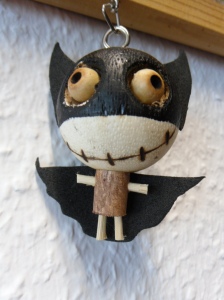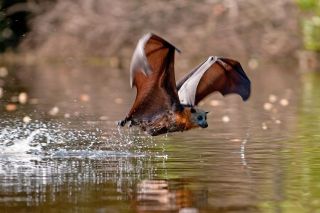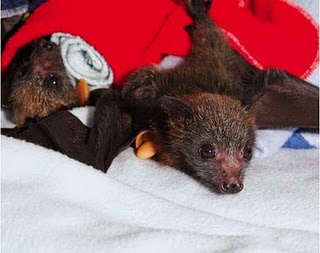Author: Eva Densing, EUROBATS Intern May – July
Inspiration and Title: Rishad Rahman, Year of the Bat Campaign Consultant
When I came to the United Nations Campus in Bonn to start my internship at the EUROBATS Secretariat, I have to admit that I had expected an experience of quite a different kind. Looking back however, I can say that I have been lucky to have worked with such wonderful colleagues and had the chance to make a difference for the Year of the Bat Campaign.
When first applying for the internship I had no idea it was the Year of the Bat. Though having worked briefly with bats before, and having a general interest in conservation issues, I thought EUROBATS might be just the place for me. And it was. “So Eva, we thought you might help with work for the Campaign during your time here” was my introduction to what I would be doing during my three months in the “Bats Secretariat”. “Sure, I would be happy to” I answered of course, not knowing what I had gotten myself into. However if I would have the chance to start all over again, I would have most definitely answered in the same way!
I will remember life at the “Year of the Bat Headquarters” in every way fun, interesting and positively challenging, though also, in a charming way unconventional.
Being able to look behind the scenes and be a director, even if a small one, in the play of this campaign was enormously interesting. I often pictured the person on the other side of that e-mail I was answering, who had for example seen our website, and the beautiful pictures of the resources and maybe thought “Wow, those are such nice resources, I will quickly write the Year of the Bat Team a mail, to send material for my event next week.”
…If you knew what an effect such a small thought of yours yields in our office, I’m sure you would be amazed. Though I will hold all those telephone calls with DSV Express and FedEx about lost shipments to Bangladesh or Macedonia, and the mails from bat-enthusiasts who do not wish to pay their customs bill in good memory. The discussions downstairs in the mailing office, about package sizes and weights, the pro-forma invoices, the printing of the address labels, when the printer strikes again all seemed tedious in the beginning, until you begin to understand that it is an inevitable part of the job and that you can make a change for the better if you master these small challenges.
Quite quickly, the “Year of the Bat Team” (Rishad and I) had worked out a nearly perfected system for packing the material. For the postcards for example it is the “sliding method” – you count the requested quantity for one set, then simply place a stack of another picture set next to it and slide it off at the same height. Same holds for the other resources: Did you for example know that 100 “Year of the Bat” Brochures weigh 1182 grams? Or that 100 Logo Stickers stack up to 2,7 centimeters? You know all of this was worth it though, when you get a mail like the one from a young girl in the States, which I remember very well. Her teacher had distributed our resources the other week, and she had been been so fascinated with bats that she had asked her teacher for our mail address, because she wanted to order more to share with her friends. “What a cool job I have!”
Correspondence within the office is quite amusing as well. As time goes by working together, communication on campaign topics seems to condense to necessities:
“Italian Lady from the tenth?”
“She’s online, it’s all good”
If your “online” this means that your event or news report has been placed in the respective areas of the website and announced on Facebook, that you have been entered into the database and that you have received an answer to your mail.
Next to shipments and “onlining” also work with the production and printing of the resources, everything that has to do with the website and the Facebook page (by the way I might take this chance to apologize for any spelling mistakes you might have found in our Facebook posts: It is very likely to have been me) and countless other jobs with all of which I have somehow built a personal connection in one way or another with, are part of life at “the HQ”.
Especially working with the resources have somehow left an impression on me. So I ask you to please, the next time you hold one of those Brochures in your hands, take a second and picture the long way it has come. From the very first inspiration of the text, to the person who read it over and over again to translate it into your language, to all the time it has been sitting on someone’s desk waiting to be edited to the long hours in front of the print-file trying to decipher the hyphenation mistakes and picture alignments until it can finally go to the publishers, the print, the travel back to our office, the packing, the e-mailing with you, the databasing the journey downstairs to the mailing office, the discussions on it’s size and weight and probably why there will most likely be problems with sending it and then the long journey to your country. Until then finally to when you open the box and take out one of these, by now, so valuable Brochures to hand it over to someone who will understand the extraordinary nature of bats a little bit more because of it.
Many people have asked me what exactly I do at the UN. In the beginning I always took great enthusiasm in explaining what exactly CMS and EUROBATS is and what they do and why. For my grandma even starting with what exactly the United Nations is in the first place. It is difficult though. Most people begin laughing when I arrive at “bat conservation”. And the amusement grows when I have to explain that I don’t actually work with bats but in an office, dealing with graphical designers, publishing houses and customs bureaus. “What good on earth will this do for bats? And why do you need an entire Secretariat and even a global Campaign for them anyway?” I usually arrive at a point where I say that I would have proudly supported the protection of dung beetles if need be, and therefore I can consider myself happy for working with such amazing animals as bats. I think conserving nature is about maintaining a balance, to which dung beetles or bats belong just as much as lions and dolphins. “Year of the Bat”!? Yes, why not. Seeing all those events, all those motivated and hard working people, all those countless packages to countless countries all over the planet I think this campaign has moved something for the better. And I am proud to have been a part of it.


